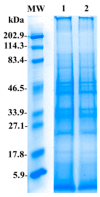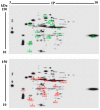Comparative Analysis of the Soluble Proteome and the Cytolytic Activity of Unbleached and Bleached Millepora complanata ("Fire Coral") from the Mexican Caribbean
- PMID: 31277227
- PMCID: PMC6669453
- DOI: 10.3390/md17070393
Comparative Analysis of the Soluble Proteome and the Cytolytic Activity of Unbleached and Bleached Millepora complanata ("Fire Coral") from the Mexican Caribbean
Abstract
Coral bleaching caused by global warming has resulted in massive damage to coral reefs worldwide. Studies addressing the consequences of elevated temperature have focused on organisms of the class Anthozoa, and up to now, there is little information regarding the mechanisms by which reef forming Hydrozoans face thermal stress. In this study, we carried out a comparative analysis of the soluble proteome and the cytolytic activity of unbleached and bleached Millepora complanata ("fire coral") that inhabited reef colonies exposed to the 2015-2016 El Niño-Southern Oscillation in the Mexican Caribbean. A differential proteomic response involving proteins implicated in key cellular processes, such as glycolysis, DNA repair, stress response, calcium homeostasis, exocytosis, and cytoskeleton organization was found in bleached hydrocorals. Four of the proteins, whose levels increased in bleached specimens, displayed sequence similarity to a phospholipase A2, an astacin-like metalloprotease, and two pore forming toxins. However, a protein, which displayed sequence similarity to a calcium-independent phospholipase A2, showed lower levels in bleached cnidarians. Accordingly, the hemolytic effect of the soluble proteome of bleached hydrocorals was significantly higher, whereas the phospholipase A2 activity was significantly reduced. Our results suggest that bleached M. complanata is capable of increasing its toxins production in order to balance the lack of nutrients supplied by its symbionts.
Keywords: Millepora complanata; coral bleaching; hydrozoa; proteomics; toxins.
Conflict of interest statement
The authors declare no conflict of interest.
Figures





Similar articles
-
Transcriptomic differences between bleached and unbleached hydrozoan Millepora complanata following the 2015-2016 ENSO in the Mexican Caribbean.PeerJ. 2023 Jan 18;11:e14626. doi: 10.7717/peerj.14626. eCollection 2023. PeerJ. 2023. PMID: 36691486 Free PMC article.
-
Impact of El Niño-Southern Oscillation 2015-2016 on the soluble proteomic profile and cytolytic activity of Millepora alcicornis ("fire coral") from the Mexican Caribbean.PeerJ. 2019 Mar 18;7:e6593. doi: 10.7717/peerj.6593. eCollection 2019. PeerJ. 2019. PMID: 30918755 Free PMC article.
-
Proteomic analysis of bleached and unbleached Acropora palmata, a threatened coral species of the Caribbean.Mar Pollut Bull. 2016 Jun 15;107(1):224-232. doi: 10.1016/j.marpolbul.2016.03.068. Epub 2016 Apr 19. Mar Pollut Bull. 2016. PMID: 27105725 Free PMC article.
-
Biology and ecology of the hydrocoral millepora on coral reefs.Adv Mar Biol. 2006;50:1-55. doi: 10.1016/S0065-2881(05)50001-4. Adv Mar Biol. 2006. PMID: 16782450 Review.
-
Coral bleaching--capacity for acclimatization and adaptation.Adv Mar Biol. 2003;46:183-223. doi: 10.1016/s0065-2881(03)46004-5. Adv Mar Biol. 2003. PMID: 14601413 Review.
Cited by
-
Marine Natural Products from the Yucatan Peninsula.Mar Drugs. 2020 Jan 16;18(1):59. doi: 10.3390/md18010059. Mar Drugs. 2020. PMID: 31963310 Free PMC article. Review.
-
Structural and evolutionary insights into astacin metallopeptidases.Front Mol Biosci. 2023 Jan 4;9:1080836. doi: 10.3389/fmolb.2022.1080836. eCollection 2022. Front Mol Biosci. 2023. PMID: 36685277 Free PMC article.
-
New Insights into the Toxin Diversity and Antimicrobial Activity of the "Fire Coral" Millepora complanata.Toxins (Basel). 2022 Mar 14;14(3):206. doi: 10.3390/toxins14030206. Toxins (Basel). 2022. PMID: 35324703 Free PMC article.
-
Transcriptomic differences between bleached and unbleached hydrozoan Millepora complanata following the 2015-2016 ENSO in the Mexican Caribbean.PeerJ. 2023 Jan 18;11:e14626. doi: 10.7717/peerj.14626. eCollection 2023. PeerJ. 2023. PMID: 36691486 Free PMC article.
-
Implications of bleaching on cnidarian venom ecology.Toxicon X. 2022 Jan 31;13:100094. doi: 10.1016/j.toxcx.2022.100094. eCollection 2022 Mar. Toxicon X. 2022. PMID: 35146416 Free PMC article. Review.
References
Publication types
MeSH terms
Substances
LinkOut - more resources
Full Text Sources

